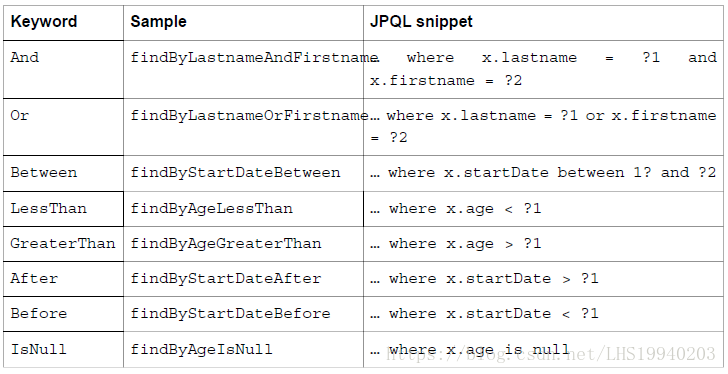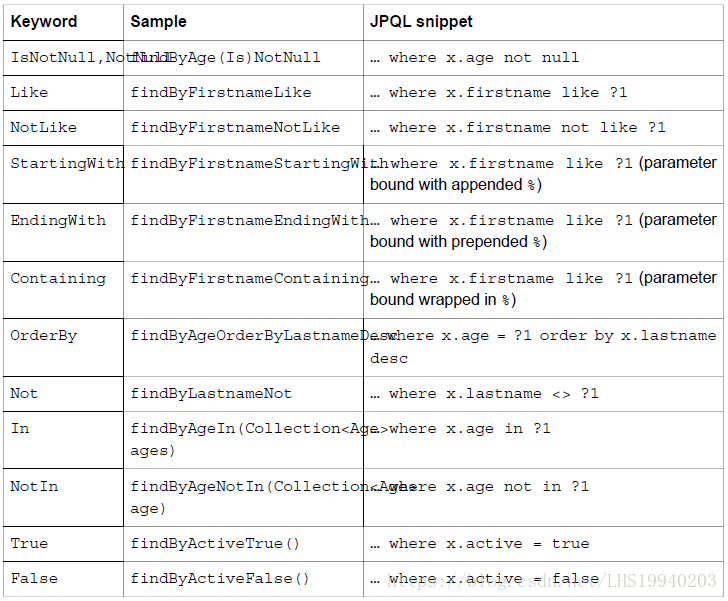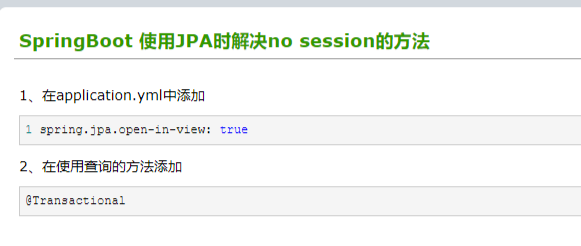spring-data-JPA repository自定义方法规则
一、自定义方法的规则


关键词 样品 JPQL片段 IsNotNull findByAgeNotNull ...其中x.age 不为空【年龄不为空】 喜欢 findByNameLike ...其中x.name是什么样的?【模糊查找是......】 不喜欢 findByNameNotLike ...其中x.name不喜欢?【模糊查找不是......】 从...开始 findByNameStartingWith ...其中x.name类似?(参数绑定附加%)【模糊匹配,类似使用%结尾】 EndingWith findByNameEndingWith ...其中x.name类似于?(参数与预置%绑定)【模糊匹配,类似使用%开始】 含 findByNameContaining ...其中x.name like?(参数绑定在%中)[模糊匹配,类似使用%开头和结尾] 排序依据 findByAgeOrderByName ...其中x.age =?order by x.name desc 【查找后排序】 不 findByNameNot ...其中x.name <>?【查找列不是...的】 在 findByAgeIn ...哪里x.age在? NotIn findByAgeNotIn ...其中x.age不在? 真正 findByActiveTrue ...其中x.avtive = true 产品嫁接 findByActiveFalse ...其中x.active = false 和 findByNameAndAge ...其中x.name =?和x.age =?2 要么 findByNameOrAge ...其中x.name =?或x.age =?2 之间 findBtAgeBetween ...其中x.age之间?和?2 少于 findByAgeLessThan ...其中x.age <? 比...更棒 findByAgeGreaterThan ...其中x.age>? 在那之后 ... ... 一片空白 findByAgeIsNull ...其中x.age为空
自定义查找实例:
/** * 根据id查用户 **/ List<User> findByIdOrName(Long id,String name); /** * 根据id查用户 **/ User queryXXXXByName(String name); /** * 根据id查name **/ User readNameById(Long id); /** * 查年龄为10岁的学生 **/ List<User> getByAge(int age);
三,Spring Data JPA分页查询:
/** * 分页查询左右用户 * @param pageable * @return */ Page<User> findAll(Pageable pageable); /** * 分页查询id不是传入id的用户 * @param id * @param pageable * @return */ Page<User> findByIdNot(Long id,Pageable pageable);
【注意】分页查询,的结果页,,页接口继承自切片,这个接口有以下方法
public interface Slice<T> extends Iterable<T> { int getNumber();//返回当前页码 int getSize();//返回当前页大小(可能不是一整页) int getNumberOfElements();//返回当前的元素数量 List<T> getContent();//返回当前页的内容(查询结果) boolean hasContent();//判断是否有内容存在 Sort getSort();//返回排序方式 boolean isFirst();//判断是不是第一页 boolean isLast();//判断是不是最后一页 boolean hasNext();//判断是否还有下一页 boolean hasPrevious();//判断是否上一页 Pageable nextPageable();//返回下一页 Pageable previousPageable();//返回上一页,如果当前已经是第一个,则返回,请求前一个可以是【null】。在调用此方法之前,客户端应该检查是否收到一个非值。 <S> Slice<S> map(Converter<? super T, ? extends S> var1);//用给定的映射,映射当前的内容,为Slice }
方法名 关键字 SQL findById 其中id =? findByIdIs 是 其中id =? findByIdEquals 等于 其中id =? findByNameAndAge 和 where name =?和年龄=? findByNameOrAge 要么 where name =?或年龄=? findByNameOrderByAgeDesc 按顺序排列 where name =?按年龄顺序排列 findByAgeNotIn 不在 年龄不在(?) findByStatusTrue 真正 where status = true findByStatusFalse 假 其中status = false findByAgeBetween 之间 年龄在哪?和? findByNameNot 不 名称<>? findByAgeLessThan 少于 年龄<? findByAgeLessThanEqual LessThanEqual 年龄<=? findByAgeGreaterThan 比...更棒 年龄>? findByAgeGreaterThanEqual GreaterThanEqual 年龄> =? findByAgeAfter 后 年龄>? findByAgeBefore 之前 年龄<? findByNameIsNull 一片空白 其中名称为空 findByNameNotNull 不为空 其中名称不为空 findByNameLike 喜欢 哪里的名字像? findByNameNotLike 不喜欢 哪里的名字不像? findByNameStartingWith 从...开始 名称如'?%' findByNameEndingWith EndingWith 名称如'%?' findByNameContaining 含 名称如'%?%'
代码中几个复杂的。
findByNameAndAgeAndSex:表示where name =?和年龄=?和性=?
findByNameInAndAgeIsNull:表示(?)中的名称和年龄为null
findByNameAndAgeInAndSexIn:表示where name =?年龄(?)和性别(?)
可以看出关键字是可以连用的,查找都是用findBy +表中列名,表的列名还有关键字等等拼接时,它们的首字母要大写。
二、懒加载引起的no-session解决方法之一,没有页面只有测试用例没有效果 
懒加载造成JPA提供的findOne方法和save 方法在关联表查询和保存时报错;所以适合单表操作,多表可以通过自定义方法分别执行
保存和更新需要通过@Query的方法执行
三、@Query注解的使用
1. 一个使用@Query注解的简单例子
@Query(value = "select name,author,price from Book b where b.price>?1 and b.price<?2") List<Book> findByPriceRange(long price1, long price2);
2. Like表达式
@Query(value = "select name,author,price from Book b where b.name like %:name%")
List<Book> findByNameMatch(@Param("name") String name);
3. 使用Native SQL Query
所谓本地查询,就是使用原生的sql语句(根据数据库的不同,在sql的语法或结构方面可能有所区别)进行查询数据库的操作。
@Query(value = "select * from book b where b.name=?1", nativeQuery = true) List<Book> findByName(String name);
4. 使用@Param注解注入参数
@Query(value = "select name,author,price from Book b where b.name = :name AND b.author=:author AND b.price=:price")
List<Book> findByNamedParam(@Param("name") String name, @Param("author") String author,
@Param("price") long price);
5. SPEL表达式(使用时请参考最后的补充说明)
'#{#entityName}'值为'Book'对象对应的数据表名称(book)。
public interface BookQueryRepositoryExample extends Repository<Book, Long>{
@Query(value = "select * from #{#entityName} b where b.name=?1", nativeQuery = true)
List<Book> findByName(String name);
}
6. 一个较完整的例子
public interface BookQueryRepositoryExample extends Repository<Book, Long> {
@Query(value = "select * from Book b where b.name=?1", nativeQuery = true)
List<Book> findByName(String name);// 此方法sql将会报错(java.lang.IllegalArgumentException),看出原因了吗,若没看出来,请看下一个例子
@Query(value = "select name,author,price from Book b where b.price>?1 and b.price<?2")
List<Book> findByPriceRange(long price1, long price2);
@Query(value = "select name,author,price from Book b where b.name like %:name%")
List<Book> findByNameMatch(@Param("name") String name);
@Query(value = "select name,author,price from Book b where b.name = :name AND b.author=:author AND b.price=:price")
List<Book> findByNamedParam(@Param("name") String name, @Param("author") String author,
@Param("price") long price);
}
7. 解释例6中错误的原因:
因为指定了nativeQuery = true,即使用原生的sql语句查询;否则表名需为实体类对象。使用java对象'Book'作为表名来查自然是不对的。只需将Book替换为表名book。
@Query(value = "select * from book b where b.name=?1", nativeQuery = true) List<Book> findByName(String name);
@Param入参有此注解,则sql中用:name接收参数;否则用?1的占位符接收参数且顺序也要一致
8. 有同学提出来了,例子5中用'#{#entityName}'为啥取不到值啊?
先来说一说'#{#entityName}'到底是个啥。从字面来看,'#{#entityName}'不就是实体类的名称么,对,他就是。
实体类Book,使用@Entity注解后,spring会将实体类Book纳入管理。默认'#{#entityName}'的值就是'Book'。
但是如果使用了@Entity(name = "book")来注解实体类Book,此时'#{#entityName}'的值就变成了'book'。
只需要在用@Entity来注解实体类时指定name为此实体类对应的表名。在原生sql语句中,就可以把'#{#entityName}'来作为数据表名使用。
9. @Modifying注解
1、在@Query注解中编写JPQL实现DELETE和UPDATE操作的时候必须加上@modifying注解,以通知Spring Data 这是一个DELETE或UPDATE操作。
2、UPDATE或者DELETE操作需要使用事务,此时需要 定义Service层,在Service层的方法上添加事务操作。







【推荐】国内首个AI IDE,深度理解中文开发场景,立即下载体验Trae
【推荐】编程新体验,更懂你的AI,立即体验豆包MarsCode编程助手
【推荐】抖音旗下AI助手豆包,你的智能百科全书,全免费不限次数
【推荐】轻量又高性能的 SSH 工具 IShell:AI 加持,快人一步
· AI与.NET技术实操系列:向量存储与相似性搜索在 .NET 中的实现
· 基于Microsoft.Extensions.AI核心库实现RAG应用
· Linux系列:如何用heaptrack跟踪.NET程序的非托管内存泄露
· 开发者必知的日志记录最佳实践
· SQL Server 2025 AI相关能力初探
· winform 绘制太阳,地球,月球 运作规律
· 震惊!C++程序真的从main开始吗?99%的程序员都答错了
· AI与.NET技术实操系列(五):向量存储与相似性搜索在 .NET 中的实现
· 超详细:普通电脑也行Windows部署deepseek R1训练数据并当服务器共享给他人
· 【硬核科普】Trae如何「偷看」你的代码?零基础破解AI编程运行原理